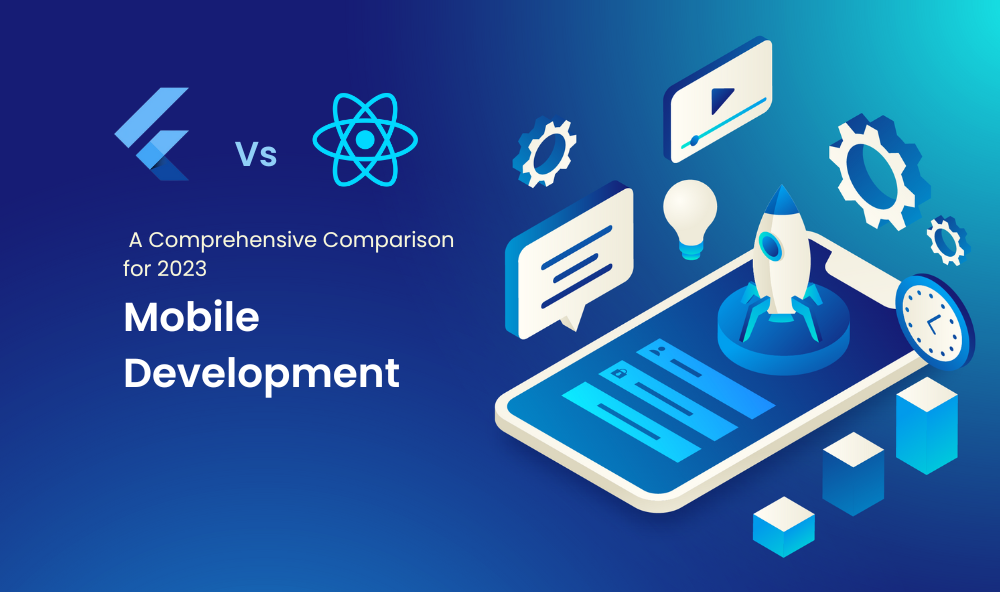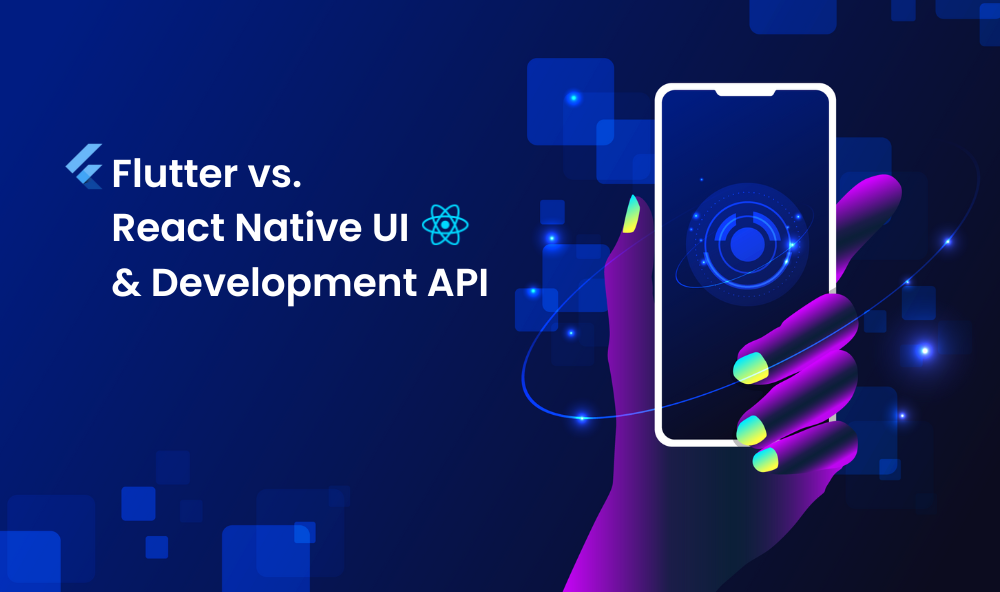
As mobile application development continues to gain momentum, the demand for powerful, flexible, and easy-to-use frameworks for building cross-platform mobile applications is increasing.
Among the many options available, two of the most popular are Flutter and React Native. Both of these frameworks have gained a significant following in recent years and continue to evolve to meet the needs when you hire flutter developers and users alike.
Flutter, developed by Google, is a relatively new framework that uses the Dart programming language to create high-performance, natively compiled applications for mobile, web, and desktop. On the other hand, React Native, developed by Facebook, is an open-source framework that uses JavaScript to build applications for both iOS and Android platforms.
In this article, we’ll take a closer look at the pros and cons of using Flutter and React Native for mobile development in 2023. We’ll examine the key features of each framework, their performance, ease of use, and community support to help you decide which one might be the best fit for your next mobile development project.
What is Flutter?
Flutter is a Google open-source platform for creating beautiful, natively compiled, cross-platform applications from only one codebase. Google first made it available in 2017.
According to Google, “Flutter’s web support relies on new advancements, providing an app-centric structure that takes maximum advantage of everything the modern web has to serve.”
The numbers for 2023 show that Flutter has grown in popularity when you hire flutter developers as compared to React Native. In comparison to earlier periods, when 30% chose Flutter, this number is increasing in 2023.
In the developer community and flutter app development companies, Flutter keeps expanding quickly and gaining in popularity.
It targets browsers like Chrome, Firefox, Safari, and Edge, in addition to operating systems for iOS, Android, Windows, macOS, and Linux. It employs a codebase for all five of these operating systems.
What is React Native?
React Native is a well-liked mobile framework for javascript that allows the creation of natively rendered mobile apps for iOS and Android from a single codebase.
In 2015, Facebook created it as an open-source undertaking. React-native has quickly risen to the top among mobile app creation tools; Instagram, Facebook, and Skype are just a few well-known examples.
It leads to a significant advantage in terms of time and resource savings because only one piece of code needs to be created.
This system enables communication with native app threads as well as Javascript-based app threads. This cross-platform programming approach uses pre-existing native concepts and components and doesn’t render web views within its code. React-native enables bidirectional contact by bridging the javascript and native communication gaps.
React Native Vs. Flutter – The differences!

Flutter vs. React Native Performance
React Native and Flutter are both popular frameworks used for developing cross-platform mobile applications. When it comes to Flutter Vs. React Native performance and both frameworks have their strengths and weaknesses.
React Native uses JavaScript and allows developers to reuse code across platforms. However, it relies on a bridge to communicate between the native code and JavaScript code, which can sometimes result in slower performance compared to native code. The performance also depends on the number of UI components and the complexity of the app.
On the other hand, Flutter uses a compiled language called Dart, which eliminates the need for a bridge and allows for faster performance compared to React Native. Flutter also has its own set of widgets and tools, which results in a smoother and more consistent UI experience across platforms.
React Native vs. Flutter Time-to-market
When it comes to time to market, both React Native and Flutter have their advantages and disadvantages.
React Native allows developers to reuse code across platforms, which can significantly reduce the development time for cross-platform mobile applications. The vast availability of open-source libraries and pre-built components also makes it easier to build applications quickly. Moreover, React Native’s hot-reload feature enables developers to see changes in real-time, which can also save time during the development process.
Flutter, on the other hand, has its own set of widgets and tools, which can help build UIs quickly and efficiently when you hire flutter developers who are skilled and efficient. As per our flutter app development company, Flutter’s hot-reload feature is faster than React Native’s, and it allows for more extensive changes without the need to recompile the entire application.
Overall, both React Native and Flutter can help developers build cross-platform mobile applications quickly. In general, React Native may be a better option for smaller projects that require quick development, while Flutter may be more suitable for larger projects with complex UI requirements.
React Native vs. Flutter Designing & Graphics
Despite having superior graphic capabilities, React Native and Flutter take distinct approaches when designing user interfaces.
React Native incorporates native graphic components and style for a seamless, customized experience. To keep the feel and similarity to other native apps, the app components will also update in accordance with operating system updates.
Regardless of the OS version and device model, the app will appear to be similar to Flutter. Other components, such as the navigation, do not alter unless upgraded on purpose. Flutter makes it simpler to adopt a uniform, neutral style across all devices in order to reduce project scope.

Flutter vs. React Native UI & development API
In addition to providing APIs for rendering user interfaces and managing devices, React Native makes use of native iOS and Android UI components. React Native significantly relies on third-party libraries because it needs them to access the majority of native modules.
Rather than utilizing native UI components, Flutter provides unique widgets that are created from inception. Flutter UI development involves a great deal of customization and is linked to UI rendering elements, device API access, movement, debugging, stateful administration, and many libraries. This comprehensive collection of components ends the reliance on outside sources. You have all the tools you need to create mobile applications with Flutter.
Flutter vs. React Native SmartPhone performance
React Native performs source code by creating a connection between Javascript code and the device’s native surroundings, improving communication and data interchange.
Nevertheless, this bridge takes more time and resources because it serves as an interpreter, converting JS code into the native computer language.
Flutter, on the other hand, does not use any intermediary levels when compiling code, leading to quicker execution code and less resource consumption. Furthermore, the C++ visual rendering engine used by Flutter enables faster and smoother animations. As a consequence, Flutter outperforms React Native in regard to mobile functionality.
Flutter vs. React Native Installation
The installation times for the development environments in Flutter and React Native differ because of their intrinsic architectural variations.
You must obtain the complete binary for the particular platform from its GitHub repository because Flutter does not employ any program links. In order to use a PATH variable during macOS download, you will also need an additional.zip file. As a result, installing Flutter takes longer and involves more stages.
If you are familiar with JavaScript, you can swiftly and easily install React Native using the node package manager. In a Flutter vs. React Native comparison, you can therefore choose React Native without much difficulty.
Flutter vs. React Native Testing Capabilities
This is yet another crucial component of selecting a specific framework for efficiently running your company operations. The testing capabilities of both systems are shown below.
Because of its potent object-oriented computer language, Dart, Flutter serves developers significantly with autonomous Flutter unit tests. It offers thorough instructions for efficient testing of Flutter applications at all levels, including interface, interaction, and unit levels.
Officially, UI level or interaction testing is not supported by React Native. It does have a few unit levels for the testing framework for React Native, though. The best aspect is that react native apps can be tested using tools like Apium, Detox, unearth bugs, etc. Developers must use Xcode to launch their apps.

Flutter vs. React Native Popularity & community support
Every year, conferences, hackathons, and activities take place in thriving communities of React Native and Flutter. Developers can simply interact with experts here and receive assistance in resolving their development-related problems.
When comparing Flutter Vs. React Native popularity and community support, and Flutter will always fall short. However, its developer user base is growing rapidly.
In the most popular area of the 2019 Stack Overflow Developer’s Survey, 75.4 percent of the respondents indicated enthusiasm for Flutter.
Since its release in 2015, it has gained popularity for its straightforward JavaScript development. Today, it has its own worldwide developer conferences, a developer network of over 10,000, and a substantial online teaching collection.
It’s a tribe, not a framework, and there is a big difference between these two frameworks.
When to choose React Native:
- Existing knowledge: If you or your team is more familiar with JavaScript and its associated tools, React Native can be a good choice as it uses JavaScript for development.
- App complexity: If your app requires a complex user interface or a high level of customization, React Native is a better choice as it allows for greater flexibility in UI development.
- Platform support: If you need to develop a wide range of platforms, including iOS, Android, and web, React Native is a good option as it supports all three.
- Community and resources: React Native has a huge and active community, which means there are plenty of resources, libraries, and tools available to help you build your app.
When to choose Flutter:
- Performance:
If your app requires high-performance graphics and animations, Flutter’s proprietary rendering engine offers superior performance. - Customization:
Flutter allows for greater customization of UI components and offers a wide range of pre-built widgets that can be easily customized. - Rapid development:
If you need to develop an app quickly, Flutter’s hot reload feature can speed up the development process, allowing you to see changes in real-time. - Consistent UI:
Flutter’s UI components are designed to look and feel the same across different platforms, making it easier to maintain a consistent user experience.
Ultimately, the choice between React Native and Flutter depends on your specific needs and priorities, so it’s important to evaluate both options and determine which one is the best fit for your project.
Final words
As we can see, there are many similarities and differences between Flutter and React Native. Both of them were created by reputable businesses: Flutter was developed by Google, whereas React Native was made by Facebook.
Particularly in the realm of mobile development, React Native has been a hot topic for a while. It’s understandable why because it completely disrupted the technology industry and was quickly embraced by giant companies like Uber, Microsoft, and Facebook.
Flutter is simpler to use because it can withstand system upgrades better. It implies that the app will stay the same even if iOS or Android updates the OS.
In conclusion, Flutter and React Native are excellent options for cutting costs and time during the creation of mobile apps. The developer’s and the company’s preferences will determine which framework to use.
We can assist you if you’re thinking about using Flutter or react native for web and mobile programming. Sufalam Technologies works with both Flutter and React Native technologies.













